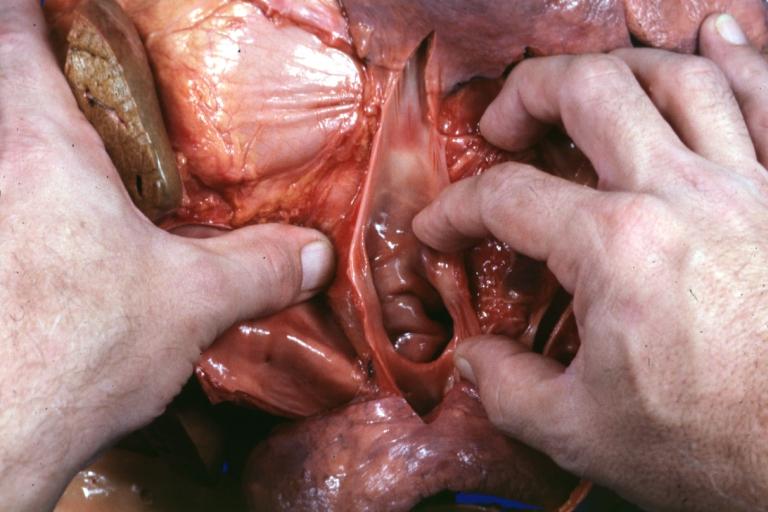Total anomalous pulmonary venous connection
| Total anomalous pulmonary venous connection | |
 | |
|---|---|
| Common pulmonary vein | |
| ICD-10 | Q26.2 |
| ICD-9 | 747.41 |
| Cardiology Network |
 Discuss Total anomalous pulmonary venous connection further in the WikiDoc Cardiology Network |
| Adult Congenital |
|---|
| Biomarkers |
| Cardiac Rehabilitation |
| Congestive Heart Failure |
| CT Angiography |
| Echocardiography |
| Electrophysiology |
| Cardiology General |
| Genetics |
| Health Economics |
| Hypertension |
| Interventional Cardiology |
| MRI |
| Nuclear Cardiology |
| Peripheral Arterial Disease |
| Prevention |
| Public Policy |
| Pulmonary Embolism |
| Stable Angina |
| Valvular Heart Disease |
| Vascular Medicine |
Editor-In-Chief: C. Michael Gibson, M.S., M.D. [1]
Associate Editors-In-Chief: Cafer Zorkun, M.D., Ph.D. [2]; Keri Shafer, M.D. [3]
Please Join in Editing This Page and Apply to be an Editor-In-Chief for this topic: There can be one or more than one Editor-In-Chief. You may also apply to be an Associate Editor-In-Chief of one of the subtopics below. Please mail us [4] to indicate your interest in serving either as an Editor-In-Chief of the entire topic or as an Associate Editor-In-Chief for a subtopic. Please be sure to attach your CV and or biographical sketch.
Overview
Total anomalous pulmonary venous connection (TAPVC), also known as total anomalous pulmonary venous drainage(TAPVD) and total anamalous pulmonary venous return(TAPVR), is a rare cyanotic congenital heart defect (CHD) in which all four pulmonary veins are malpositioned and make anomalous connections to the systemic venous circulation. (Normally, pulmonary venous return carries oxygenated blood to the left atrium and to the rest of the body). A patent foramen ovale or an atrial septal defect must be present in order to allow systemic blood flow.
Variations
There are four variants:
- Supracardiac (50%): blood drains to one of the innominate veins (brachiocephalic veins) or the superior vena cava
- Cardiac (20%): blood drains into coronary sinus or directly into right atrium
- Infradiaphragmatic (20%): blood drains into portal or hepatic veins
- Mixed (10%)
TAPVC can occur with obstruction, which occurs when the anomalous vein enters a vessel at an acute angle and can cause pulmonary venous hypertension and cyanosis because blood cannot easily enter the new vein as easily.
Diagnosis
Symptoms
- cyanosis, tachypnea, dyspnea since the overloaded pulmonary circuit can cause pulmonary edema
Physical Examination
- right ventricular heave
- fixed split S2
- S3 gallop
- systolic ejection murmur at left upper sternal border
- cardiomegaly
Electrocardiographic Findings
Cardiac Catheterization
<googlevideo>4462444442806796487&hl=en</googlevideo>
<googlevideo>-3314937685295122195&hl=en</googlevideo>
<googlevideo>2240824856713063576&pr=goog-sl</googlevideo>
<googlevideo>4846170916216525758&hl=en</googlevideo>
<googlevideo>2692134944789571414&hl=en</googlevideo>
<googlevideo>961264589763540810&hl=en</googlevideo>
<googlevideo>613495638748988173&hl=en</googlevideo>
Treatment
In TAPVC without obstruction, surgical redirection can be performed within the first month of life. With obstruction, surgery should be undertaken emergently. PGE1 should not be given because a patent ductus arteriosus adds even more volume into the already overloaded pulmonary flow.
External links
- Total Anomalous Pulmonary Venous Return information from Seattle Children's Hospital Heart Center
Additional Reading
- Moss and Adams' Heart Disease in Infants, Children, and Adolescents Hugh D. Allen, Arthur J. Moss, David J. Driscoll, Forrest H. Adams, Timothy F. Feltes, Robert E. Shaddy, 2007 ISBN 0781786843